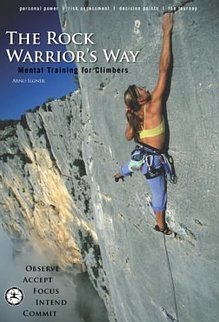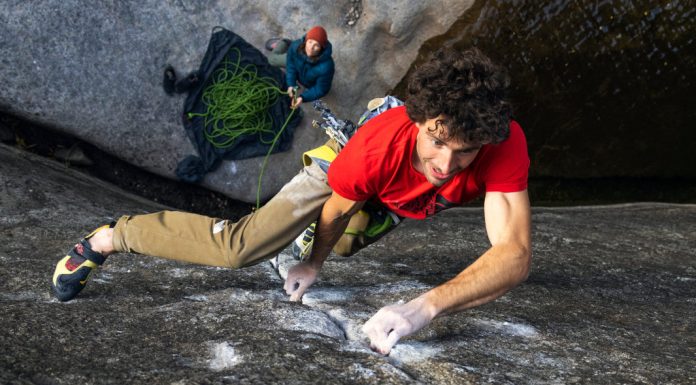 Risk Assessment
Risk Assessment
Mental toughness can lead to taking inappropriate risks because the end goal can interfere with assessing the situation effectively. Mental flexibility allows you to take appropriate risks. When you are stopped at a stance, assess the situation, and then make a decision that will lead to taking an appropriate risk.
Climbing has ìno-fallî and ìyes-fallî risks. You determine appropriateness differently for each of these. In no-fall risks you weigh the strength, skill, and confidence you have left, compared to what is left to climb, in order to pass through the difficulties and not fall. You usually climb more slowly, stay on routes below your technical ability, and you do listen to your mind when it determines you canít or shouldnít continue.
In yes-fall risks you weigh the fall consequence you faceólength of fall, obstacles, etc.óagainst your actual experience taking such falls. You climb more quickly, get on routes at or above your technical ability, and you donít listen to your mind when it says you canít continue.
A primary part of mental flexibility is determining what type of risk you are in and then engaging accordingly. Many climbs have both yes- and no-fall zones. You could be on a runout trad climb, like Zoo View, that youíd label no-fall but has yes-fall zones close to solid pro. Or, you could be on a sport climb that you tend to think of as yes-fall but has sections where a fall could cause injury, like climbing to the first or second bolt or where the bolts are farther apart. Being mentally flexible means you do assessment several times on a climb and then engage accordingly. Mental toughness doesnít have the flexibility to adapt to these distinctions.
Craig had climbed Zoo View before without much difficulty so it was within his technical difficulty. But the second time he was off route, not knowing it at the time, facing a no-fall situation in a state of fatigue. His mind, however, insisted that he was on route and ignored the feedback his body and the climb were giving him. His mind was tough and rigid, clinging to its false perceptions. After taking a Warriorís Way course Craig learned how to be mentally flexible.He learned that the risk on Zoo View was no-fall and not appropriate to engage when the chance of falling was great. He also learned options he could have acted on based on the feedback he was getting from the situation. Doing this would keep him from being drawn in by the justifications of his mind. He could have down-climbed to his last stance to regroup and reassess. He could have rested at his current stance to regain strength.
Doing this would have allowed him to see if he could collect enough strength to climb the no-fall section without falling. Or, he could have looked for more pro where he was, to convert the no-fall section into a yes-fall section. All of these flexible options would have been based on what was actually happening on the climb, not based on mental justifications about what should be happening.Matter (the body and the climb) directs the mind on how pumped you are, whether you face a no-fall or yes-fall section, and how to engaged based on the type of risk it is. Then the mind simply needs to stay flexible as the body engages appropriately. Climbing in a matter-over-mind approach allows you to keep attention fully on the task, based on the type of risk.
Mental toughness tends to force the mindís current perceptions onto the climbóa mind-over-matter approach. Mental flexibility keeps the mindís limiting perceptions from interfering with the feedback the body is currently experiencingóa matter-over-mind approach. Craig learned effective risk assessment for challenging climbs that he applied while taking the Warriorís Way course. Most important, though, he learned the value of staying mentally flexible so he could process whatever happens on the climb to insure he engages appropriate to the risk and still performs at his best.
Go to www.warriorsway.com for more information.


![[VIDEO] Alexander Megos: URSUS | The days after the send URSUS | The days after the send (c) Alexander Megos](https://www.climbing.de/wp-content/uploads/2024/03/youtube_WCZVR9-tZTc-218x150.jpg)

![[VIDEO] Stefano Ghisolfi: ALL my secrets about ENDURANCE Stefano Ghisolfi: ALL my secrets about ENDURANCE (c) Stefano Ghisolfi](https://www.climbing.de/wp-content/uploads/2024/03/youtube_xlQ2OreHL60-218x150.jpg)
![[VIDEO] THE FULL JOURNEY 9B FA by Alexander Megos THE FULL JOURNEY 9B FA by Alexander Megos (c) Alexander Megos](https://www.climbing.de/wp-content/uploads/2022/12/youtube_QwjykRehg7M-218x150.jpg)
![[VIDEO] MEGATRON V17 MEGATRON V17 (c) mellow](https://www.climbing.de/wp-content/uploads/2022/12/youtube_f_MniTA8MYU-218x150.jpg)
![[VIDEO] Moulin Rouge (7b) Free Solo | Jonas Hainz Moulin Rouge - Free Solo (c) Jonas Hainz](https://www.climbing.de/wp-content/uploads/2022/10/youtube_UQs4KNRBHss-218x150.jpg)
![[VIDEO] Gimme Kraft! Trailer](https://www.climbing.de/wp-content/uploads/2014/12/vimeo_69235663-150x150.jpg)
![[VIDEO] Trainingstag mit Jürgen Reis](https://www.climbing.de/wp-content/uploads/2014/12/youtube_JAwFSu3xNlI-150x150.jpg)
![[VIDEO] Chris Webb Parsons in England](https://www.climbing.de/wp-content/uploads/2014/12/vimeo_34136101-150x150.jpg)
![[VIDEO] Markus Bendler: Eisprinz - Teil 1](https://www.climbing.de/wp-content/uploads/2014/12/vimeo_36429174-150x150.jpg)








